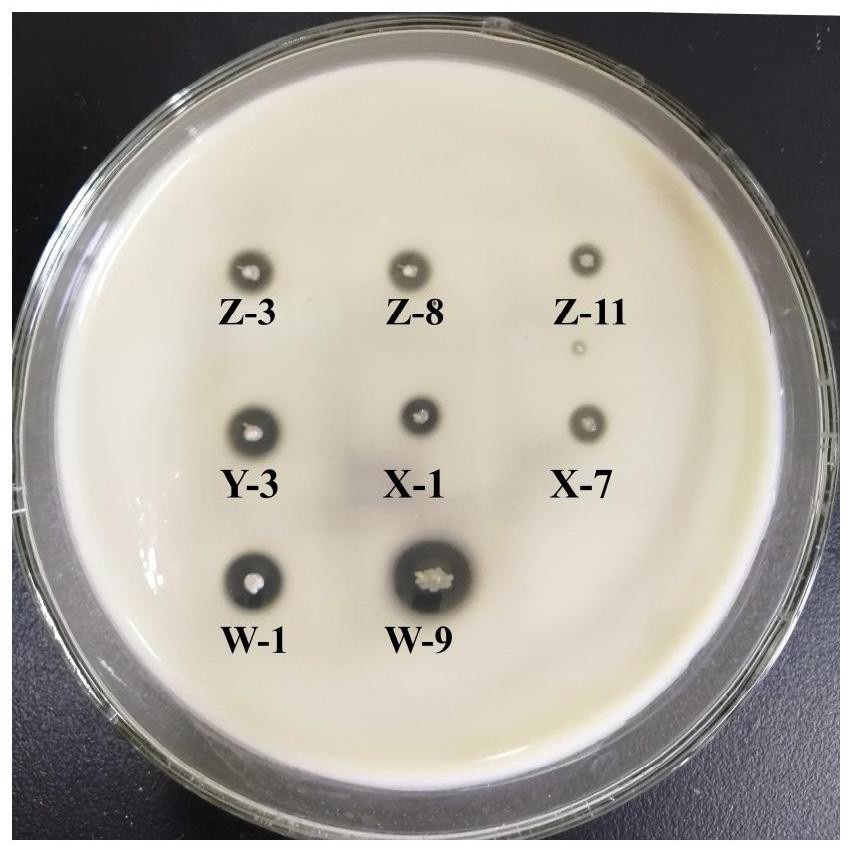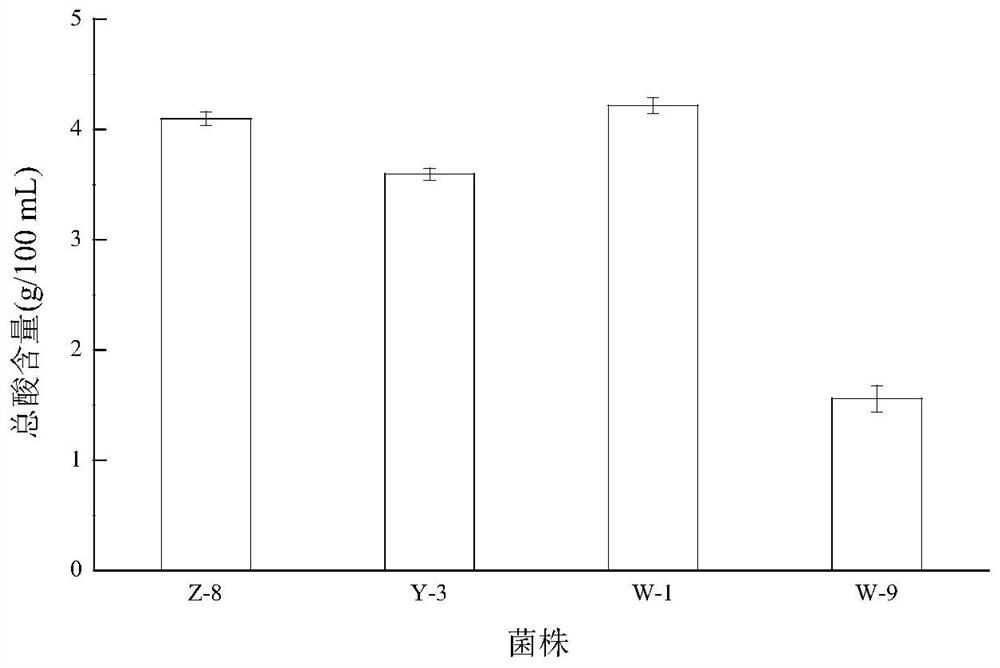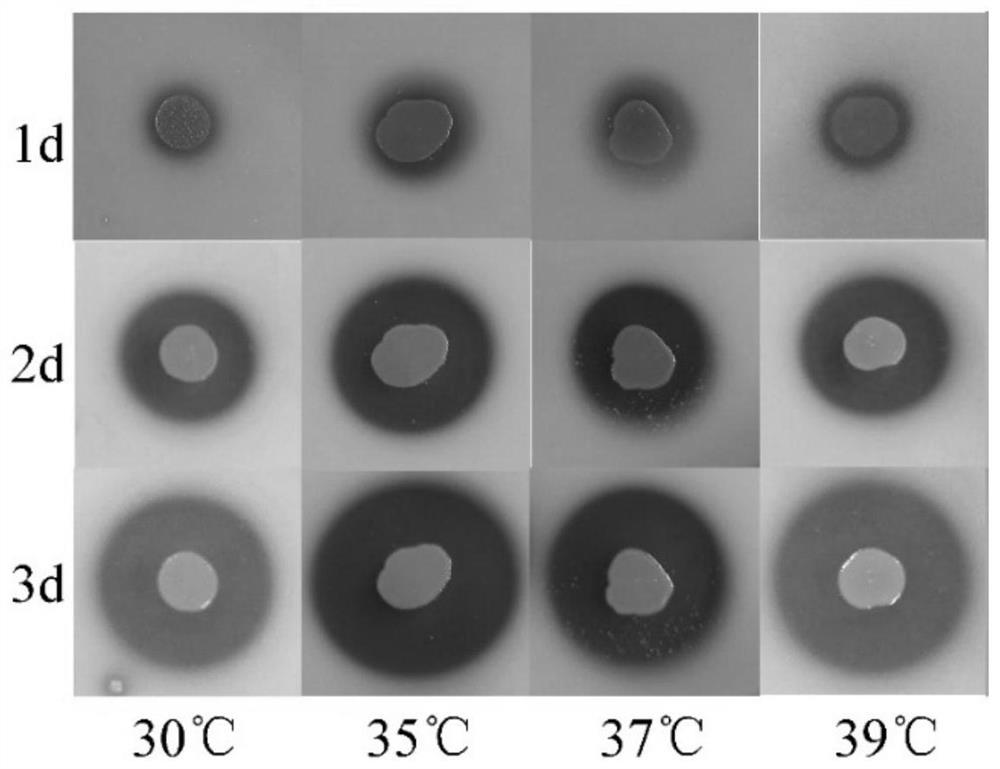Gluconobacter oxydans and application thereof
A technology of Gluconobacter oxidans and acetic acid bacteria, which is applied in the field of microbial application and food brewing, can solve the problems of few types of non-volatile organic acids, weak ability to produce total acid and acetic acid, and low content, so as to achieve good flavor and The effect of good flavor quality and high yield
- Summary
- Abstract
- Description
- Claims
- Application Information
AI Technical Summary
Problems solved by technology
Method used
Image
Examples
Embodiment 1
[0037] Embodiment 1: Isolation and screening of bacterial strain W-1
[0038] 1) Raw material
[0039] The rotten figs with a relatively sour taste that matured in August in Weihai, Shandong were selected.
[0040] 2) Strain isolation
[0041] ① Strain enrichment culture
[0042] The rotten part of the fig was placed in the liquid seed culture medium, 30° C., 180 rpm, and enriched for 20 hours to obtain an enriched culture solution.
[0043] Liquid seed medium composition: glucose 20g / L, yeast extract powder 10g / L, ethanol 30mL / L, pH6.0.
[0044] ②Strain isolation
[0045] The enriched culture medium from the rotten part of figs was diluted in gradient, spread on a common solid medium plate, and cultured upside down at 30°C for 72 hours. Pick out the strain that produces the transparent circle, and name it.
[0046] Ordinary solid medium composition: glucose 20g / L, yeast extract powder 10g / L, agar powder 20g / L, calcium carbonate 20g / L, ethanol 20ml / L.
[0047] 3) Primar...
Embodiment 2
[0067] Example 2: Identification of bacterial strain W-1
[0068] 1) Physiological and biochemical identification of strain W-1
[0069] Gram staining, oxidized ethanol test, oxidized acetic acid test, oxidized lactic acid test, detection of catalase and oxidase test for physiological and biochemical identification of strain W-1, the results are as follows Figure 6 and shown in Table 2.
[0070] Table 2: Physiological and biochemical identification results of strain W-1
[0071]
[0072] Note: "+" in the table means positive, and "-" means negative.
[0073] Depend on Figure 6 It can be seen from Table 2 that the strain W-1 is a Gram-negative strain with a short rod shape and a size of 0.63-0.76 μm×1.19-1.51 μm. It can oxidize ethanol to produce acetic acid, but cannot oxidize acetic acid and lactic acid. Others The test results are also consistent with the physiological and biochemical characteristics of Gluconobacter in the "Common Bacteria System Identification Man...
Embodiment 3
[0089] Example 3 Experiment of acid production characteristics of Gluconobacter oxydans W-1
[0090] 1) Preparation of seed solution
[0091] The W-1 strain was inserted into the liquid seed medium, and cultured at 30° C. and 180 rpm for 20 hours to obtain the seed liquid.
[0092]2) Batch fermentation experiment
[0093] Take 5mL of the seed liquid of strain W-1 and connect it to the liquid fermentation medium, ferment and cultivate it at 30°C and 180rpm, measure the cell concentration (absorbance value at wavelength 540nm) and total acid every 1d (refer to GB / T 5009.41 for the test method) content, and calculate the acid production rate, the results are shown in Figure 9 .
[0094] Depend on Figure 9 As shown, during the fermentation process of strain W-1, the cell concentration and total acid content showed a gradual increase trend, and the total acid content reached 4.70±0.02g / 100mL after 6 days of fermentation. The acid production rate increased first and then decr...
PUM
 Login to View More
Login to View More Abstract
Description
Claims
Application Information
 Login to View More
Login to View More - R&D
- Intellectual Property
- Life Sciences
- Materials
- Tech Scout
- Unparalleled Data Quality
- Higher Quality Content
- 60% Fewer Hallucinations
Browse by: Latest US Patents, China's latest patents, Technical Efficacy Thesaurus, Application Domain, Technology Topic, Popular Technical Reports.
© 2025 PatSnap. All rights reserved.Legal|Privacy policy|Modern Slavery Act Transparency Statement|Sitemap|About US| Contact US: help@patsnap.com



